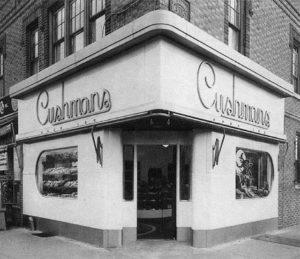Okay. “Goyish” means not Jewish. And, “goyish” bakeries abounded in The Bronx of HG’s young days. The Cushman’s chain was venerable. It had a 109-year history with the last unit (in the Port Authority Bus Terminal) closing in 2014. At its height, Cushman’s had 45 stores in New York. Closed them in 1964. Cushman stores had a makeover in the 1930’s. They were instantly recognizable with their beautiful art deco exteriors. Art deco design denoted optimism during the dark days of the Great Depression as exemplified by the exquisite Grand Concourse apartment buildings that can still be viewed today. Cushman’s sold splendid cookies and a lush, egg shaped pastry filled with custard. Hanscom’s was another big chain with exterior design by architect Horace Ginsbern (later the favorite architect of post-World War Two apartment house developers in New York). Their chocolate cream pie was heavenly. The chain went out of business in 1956. Sometimes little HG took a long walk to the Italian bakeries on Arthur Avenue off Fordham Road. Brought back glorious loaves of Italian bread, pignolia cookies and cannoli. (During their New York days. HG/BSK’s favorite Italian bakery was Zito’s on Bleecker Street. Incomparable loaves). The greatest of all bakeries was Sutter’s. Spacious store on the Grand Concourse in The Bronx plus branches in Manhattan (Greenwich Village) and Brooklyn (Flatbush). Sutter’s utilized three baking styles–French, Danish and Viennese. Wonderful croissants and brioche. Pecan rings, And (sorry, Paris) the best baba au rhum in the world.
Bronx Bakeries: Goyish
May 9th, 2018 § 0 comments § permalink
When Muffins Met Modernism & A Jewish Bakery Detour
June 13th, 2012 § 0 comments § permalink
In 1930s New York, many apartment buildings, shops (and restaurants) were designed in a streamlined, modernist style — a kind of Art Deco for the masses. While true Art Deco (which reached its height in Paris of the 20s and 30s) was very elegant and seriously luxurious, the young American designers who piggy backed on the Art Deco style were a bit more egalitarian. Their best efforts, in terms of major structures, can be seen in the apartment houses that line the Grand Concourse in the Bronx and the glorious hotels of Miami’s South Beach. Smaller design gems were the chain bakeries that flourished in all of New York’s neighborhoods. The aim of all the “streamlining” was to give shoppers an optimistic lift in the gloom of the Great Depression. The “streamlined” bakeries were Cushman’s and Hanscom’s. The famed industrial designer Raymond M. Loewy designed Cushman’s and Horace Ginsbern designed Hanscom’s. (Ginsbern, then fairly young, later became one of New York’s most prominent apartment house architects. Ginsbern was born in 1893 and died in 1969. Scores of his buildings exist in Manhattan’s Upper East Side).
The architect Robert A.M. Stern has commented on the Loewy and Ginsbern bakery designs: “They brought a relatively high level of International Style Modernism into virtually every New York neighborhood.”
Cushman’s had white porcelain facades; nautical, oval windows and the name was spelled out in a curving, gold script. Hanscom’s had apple green porcelain facades and the name was formed with blocky, super- modern letters. Stern described the entire architectual composition as “Constructivist.”
In the Bronx you had Jewish Bakeries and Italian bakeries. The Jewish bakeries had elaborate butter cream cakes and, of course, bagels, bialys, rye and pumpernickel bread, etc. These were jammed on Sunday mornings with Dads buying bread-stuffs for brunch (The casual tweed and camel hair jackets many of them wore were known as “bagel coats”). The Italian bakeries, in neighborhoods like Belmont, had, of course, sublime bread, delicious cannolis, pignoli cookies and other Italian specialties. There was plenty of cross pollination. Jews liked the corn muffins and cookies at Cushman’s and Hanscom’s (which were generalized as goyish bakeries) and there were plenty of bagel and rye bread fanciers among the non-Jewish population. And, of course, everyone loved their Italian baked goods. Some Jewish bakery survivors in Manhattan are Moishe’s Bakery on 2nd Ave, Streit’s, which bakes and sells matzos, macaroons, kichel and other stuff from a 47,000 foot factory on Rivington Street and Kossar’s which bakes and sells bialys and other traditional good stuff from a location near the Essex Street Market. SJ sent HG a batch of Kossar’s products a few months ago producing moans of delight. The eminent food writer, Mimi Sheraton, a woman who knows Jewish food, says a Kossar’s bialy is the only true bialy baked in the United States. HG agrees.
Interestingly, HG’s Mom never called a bialy by that shortened name. She paid appropriate homage by calling it a Bialyosteker Kuchen.

